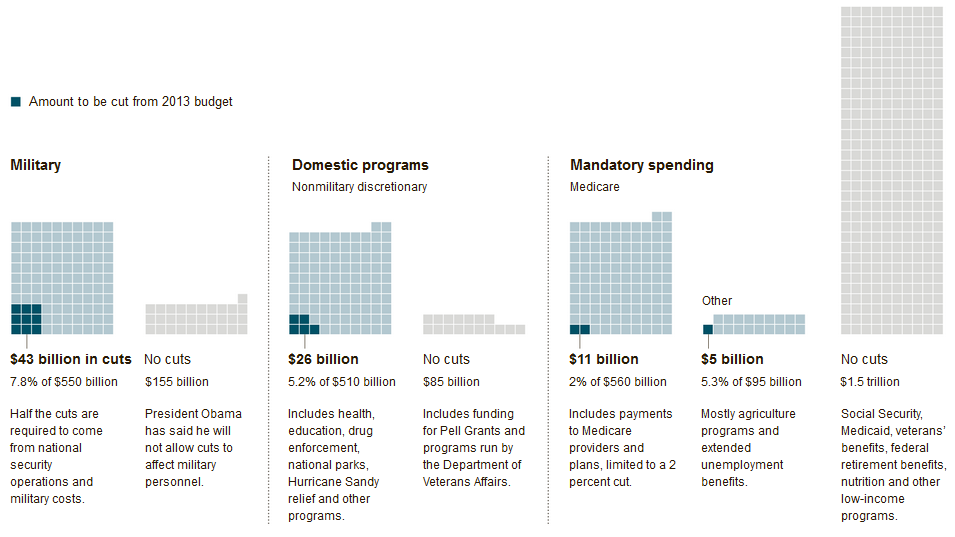Unintended Consequences of the Sequester
There has been a lot of talk about the sequester in recent weeks as the latest in a long line of fiscal stand-offs ensues in Washington. In FY 2013, the sequester will hit defense budget authority by $43 billion, non-defense discretionary budget authority by $26 billion, Medicare spending by $11 billion, and other mandatory spending by $5 billion.
The chart below from the New York Times shows that while the cuts themselves are significant, a good deal of spending is excluded from sequestration, especially spending on entitlement programs. We need to do something about our unsustainable budget and the sequester is better than nothing, but almost everyone agrees that the sequester is a dumb way to reduce the deficit. It includes severe cuts up front that would harm the economy, hinders the federal government's ability to provide basic services through across-the-board cuts, and does not address the drivers of our long-term debt.
Source: New York Times
Scott Lilly of the Center for American Progress points out another way in which the sequester cuts are not smart: in some cases, the cuts may increase the deficit. For one, the sequester's hit to the economy would depress revenue and increase spending on countercyclical programs (although the effect would most likely not wipe out the initial savings fully over ten years). Lilly further points out that the economic contraction may actually be bigger than anticipated, since the sequester may have further ripple effects beyond what a simple multiplier analysis would indicate. For example, cuts to the Federal Aviation Administration (FAA) could lead not just to fewer jobs at the agency and related effects, but it also could hurt the airline industry by reducing the number of flights that they can operate. This kind of disruption is not typically experienced with other kinds of cuts.
Also, because of the way some of the affected spending works, some cuts may actually have no impact or even a negative impact on the deficit. To use the FAA as an example again, since the sequester cuts could reduce the number of flights and the FAA is largely funded by user fees collected on a per flight basis, the agency's savings from the budget cuts would mostly be erased by losses in revenue. This would be a worst of both worlds result -- disrupted service with little or no savings to show for it.
Other examples of counterproductive cuts include the IRS and the Center for Medicare and Medicaid Services (CMS). The IRS, of course, is responsible for collecting revenue, so cuts to their budget would result in less revenue collection, likely an amount that is greater than the initial cuts. We've seen that the reverse is true with the Senate version of the Budget Control Act, which increased funding for the IRS by $14 billion over ten years and was scored as increasing revenue by $44 billion (a net $30 billion gain). In the case of CMS, they preside over an enormous budget that will shrink only a little -- Medicare will be cut by 2 percent and Medicaid is exempt -- while their own budget will shrink by 9 percent, according to Lilly. And even if the size of Medicare payments is smaller, the number of payments CMS must process will not shrink. As a result, it is quite possible that the increase in improper payments would swamp the initial savings from cutting CMS's budget. As you can imagine, there are plenty of other examples of sequester cuts which would hamper agencies' abilities to maintain budgetary discipline.
Clearly, the sequester is not a smart way to reduce the deficit, but that does not mean it should be repealed without offsets--that would be a clear step back in the effort to get our budget on a sustainable path. Instead, lawmakers should make much smarter choices by working to get our debt under control with more gradual changes. This plan should also go much further than the sequester and tackle the long-term drivers of our debt so that, unlike the sequester, it can make our long-term fiscal future much brighter. Lawmakers should take advantage of this moment and enact a smart deficit reduction plan as a replacement, as described in Fix the Debt's report card. The sequester debate is an opportunity as much as it is a problem.


